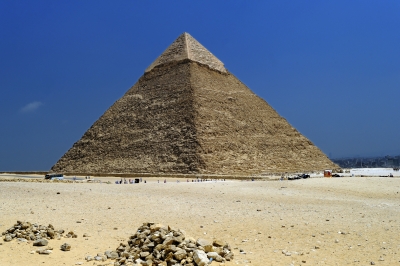A very, very, very large tomb.
- The Great Pyramid of Giza is also known as Pyramid of Khufu and Pyramid of Cheops.
- The Great Pyramid of Giza is believed to be a burial pyramid for Pharaoh Khufu, and is located near Cairo, Egypt.
- The Great Pyramid of Giza is said to have taken 10 to 20 years to be built, and was built around 2500-2600 BC.
- The Great Pyramid of Giza was originally 146.5 metres (481 feet) in height (although it is now about 9 metres shorter), being the tallest man-made structure until around 1300 AD, 3800 years since construction, and is equivalent to a modern 48 storey building.
- The Great Pyramid of Giza is the only discovered Egyptian pyramid that has pathways that go up and down.
The Great Pyramid of Giza
Image courtesy of Arvind Balaraman/ Free Digital Photos
- It is estimated that 2,300,000 limestone blocks were used in the construction of the Great Pyramid of Giza, most of them weighing 2 tonnes (2.2 tons) each, and the pyramid was covered with smooth casing stones which were taken and used to build some of the buildings in Cairo.
- The entrance to the Great Pyramid of Giza is 17 meters (56 feet) above ground level, so tourists use the Robbers’ tunnel to enter the pyramid.
- The Great Pyramid of Giza covers an area of 13 acres (5.2 hectares) and is oriented to the four main compass points.
- Three pits sit around the Great Pyramid of Giza, all boat shaped, and a fourth hidden pit contained 1,224 wooden pieces of a boat, which was assembled over a period of 14 years, to make a 43.6 metres (143 ft) long boat.
- The Great Pyramid of Giza is one of the Seven Wonders of the Ancient World.





